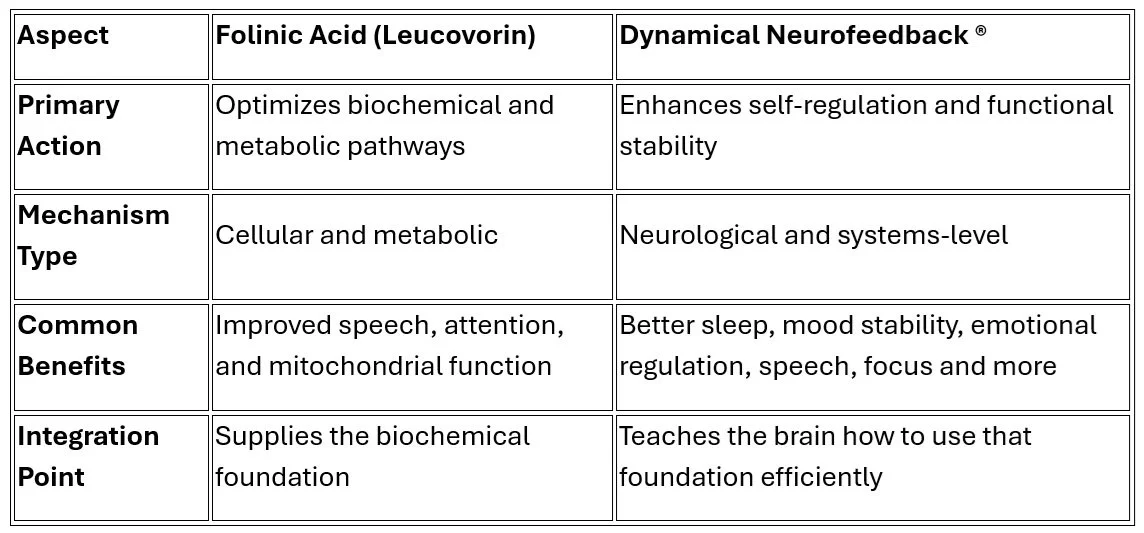How Neurofeedback and Folinic Acid Work Together to Support Speech and Regulation in Autism
Over the years at the Executive Brain Mastery, and as industry leader in natural health in Australia, I have worked with many experts and families exploring metabolic and neurological approaches to help their autistic children communicate and self-regulate more effectively.
Two interventions that stand out for their potential to complement each other are Folinic acid (Leucovorin) and Dynamical Neurofeedback®.
Folinic acid (a form of Vitamin B9) supports the body’s underlying biochemistry, while Neurofeedback helps the brain adapt functionally to those biochemical shifts.
When combined under professional guidance, these two approaches can open new pathways for speech, learning, and emotional balance.
Why Supplements Can Make a Difference
Many autistic children experience subtle metabolic inefficiencies that affect how their brains use energy and produce neurotransmitters. Folinic acid is the active, bioavailable form of folate that bypasses some of the common bottlenecks in folate metabolism. In clinical studies led by Dr. Richard Frye and colleagues, children who tested positive for folate receptor alpha autoantibodies (FRAAs) often showed improvements in speech, attention, and social engagement after folinic acid supplementation.
Folinic acid supports:
Mitochondrial energy production (helping neurons maintain stable signaling)
Methylation and one-carbon metabolism (key for dopamine, serotonin, and GABA balance)
DNA repair and myelination, essential for cognitive development
Even without specific testing, some integrative doctors choose to trial folinic acid when clinical symptoms fit the metabolic profile described in research.
However, the shift in neurochemistry can be significant and sudden - especially when the child’s system has adapted to an earlier metabolic state.
That’s where Neurofeedback often plays an important role.
How Neurofeedback Supports Children on Metabolic Treatments
When children begin supplements like folinic acid, methylcobalamin, or mitochondrial cofactors (e.g., carnitine, CoQ10, NAC, Glutathione and many more…), their neurotransmitter dynamics and network activation can change quite rapidly. This biochemical improvement doesn’t always translate immediately into functional regulation.
In some cases, parents notice initial changes in sleep, mood, or emotional reactivity. These are not necessarily negative - they reflect the brain adjusting to its new metabolic environment.
Dynamical Neurofeedback® helps guide that adjustment process.
By providing the brain with precise, moment-to-moment feedback on its own activity, Neurofeedback supports the natural recalibration of neural networks. In simple terms, while supplements provide the biochemical potential, Neurofeedback helps the brain organize and use that potential effectively.
Helping the Brain Integrate Neurotransmitter Changes
The brain’s chemistry and electrical activity are in constant dialogue. When metabolic support increases neurotransmitter availability - such as dopamine, serotonin, or GABA - the entire system must learn how to function with new “rules of balance.”
Dynamical Neurofeedback® helps the brain self-regulate through this adaptation phase. It acts like a mirror that allows the brain to notice and correct its own fluctuations, promoting stability, improved timing, and smoother communication across networks. This process helps reduce overactivation, irritability, or restlessness that sometimes appear during metabolic or dietary interventions.
In clinical observation, Neurofeedback often shortens the adjustment period, leading to more consistent progress and better tolerance of new supplements.
How These Two Approaches Complement Each Other
Together, they address both the hardware and software aspects of the brain. One improves the metabolic landscape, the other ensures that the system can operate efficiently within it.
Guidance for Parents
Parents interested in this integrative approach should seek advice from qualified professionals such as:
Integrative or functional medicine doctors experienced in metabolic and nutritional therapies
Pediatricians who understand developmental neurochemistry
Neurofeedback practitioners trained and experienced in Dynamical Neurofeedback® for Autism
Collaboration between practitioners is essential.
By coordinating care, families can ensure that biochemical, neurological, and behavioral perspectives all work together toward the same goal: helping the child’s brain function with greater stability, adaptability, and communication capacity.
In Summary
Folinic acid and Dynamical Neurofeedback® represent two sides of a powerful integrative framework.
Folinic acid supports the biochemical efficiency of the brain, improving the energy and neurotransmitter balance needed for learning.
Neurofeedback strengthens the functional adaptability of the brain, helping it regulate itself as those biochemical improvements take effect.
Through years of clinical observation, I have seen how combining these approaches - under appropriate professional guidance - can make progress more stable and sustainable for autistic children and their families.
We can help you understand where Neurofeedback fits into your child’s broader treatment plan and we explain role of metabolic therapies, probiotics and microbiome, heavy metal toxicity or other aspects that may contribute to the condition your loved one suffers from.
Further, we can connect you with experienced integrative practitioners to actively manage these health aspects.
If you’d like to explore this integrative pathway, you’re welcome to reach out to Executive Brain Mastery.


